Related Research Articles

In ancient Greek mythology and religion, Persephone, also called Kore or Cora, is the daughter of Zeus and Demeter. She became the queen of the underworld after her abduction by her uncle Hades, the king of the underworld.

Mystery religions, mystery cults, sacred mysteries or simply mysteries, were religious schools of the Greco-Roman world for which participation was reserved to initiates (mystai). The main characterization of this religion is the secrecy associated with the particulars of the initiation and the ritual practice, which may not be revealed to outsiders. The most famous mysteries of Greco-Roman antiquity were the Eleusinian Mysteries, which predated the Greek Dark Ages. The mystery schools flourished in Late Antiquity; Julian the Apostate in the mid 4th century is known to have been initiated into three distinct mystery schools—most notably the mithraists. Due to the secret nature of the school, and because the mystery religions of Late Antiquity were persecuted by the Christian Roman Empire from the 4th century, the details of these religious practices are derived from descriptions, imagery and cross-cultural studies. Much information on the Mysteries come from Marcus Terentius Varro.
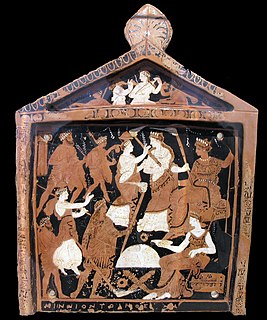
The Eleusinian Mysteries were initiations held every year for the cult of Demeter and Persephone based at the Panhellenic Sanctuary of Elefsina in ancient Greece. They are the "most famous of the secret religious rites of ancient Greece". Their basis was an old agrarian cult, and there is some evidence that they were derived from the religious practices of the Mycenean period. The Mysteries represented the myth of the abduction of Persephone from her mother Demeter by the king of the underworld Hades, in a cycle with three phases: the descent (loss), the search, and the ascent, with the main theme being the ascent of Persephone and the reunion with her mother. It was a major festival during the Hellenic era, and later spread to Rome. Similar religious rites appear in the agricultural societies of the Near East and in Minoan Crete.
In ancient Greek religion and mythology, Iacchus was a minor deity, of some cultic importance, particularly at Athens and Eleusis in connection with the Eleusinian mysteries, but without any significant mythology. He perhaps originated as the personification of the ritual exclamation Iacche! cried out during the Eleusinian procession from Athens to Eleusis. He was often identified with Dionysus, perhaps because of the resemblance of the names Iacchus and Bacchus, another name for Dionysus. By various accounts he was a son of Demeter, or a son of Persephone, identical with Dionysus Zagreus, or a son of Dionysus.

Kykeon was an Ancient Greek drink of various descriptions. Some were made mainly of water, barley and naturally occurring substances. Others were made with wine and grated cheese. It is widely believed that kykeon usually refers to a psychoactive compounded brew, as in the case of the Eleusinian Mysteries. A kykeon was used at the climax of the Eleusinian Mysteries to break a sacred fast, but it is also mentioned as a favourite drink of Greek peasants.
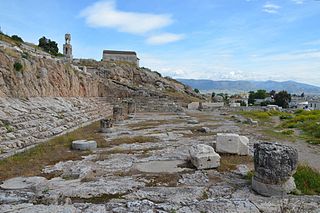
The Telesterion was a great hall and sanctuary in Eleusis, one of the primary centers of the Eleusinian Mysteries. The hall had a fifty-five yard square roof that could cover three-thousand people, but no one revealed what happened during these events beyond there being "something done, something said, and something shown". This building was built in the 7th century BCE and was an important site until it was destroyed in the 4th century CE. Devoted to Demeter and Persephone, these initiation ceremonies were the most sacred and ancient of all the religious rites celebrated in Greece.
The Eumolpidae were a family of priests at Eleusis who maintained the Eleusinian Mysteries during the Hellenic era. As hierophants, they popularized the cult and allowed many more to be initiated into the secrets of Demeter and Persephone.

Elefsina or Eleusis is a suburban city and municipality in West Attica Regional unit in Greece. It is situated about 18 kilometres northwest from the centre of Athens and is part of its metropolitan area. It is located in the Thriasio Plain, at the northernmost end of the Saronic Gulf. North of Elefsina are Mandra and Magoula, while Aspropyrgos is to the northeast.
In Greek Mythology, Eumolpus was a legendary king of Thrace. He was described as having come to Attica either as a bard, a warrior, or a priest of Demeter and Dionysus.

Orphism is the name given to a set of religious beliefs and practices originating in the ancient Greek and Hellenistic world, associated with literature ascribed to the mythical poet Orpheus, who descended into the Greek underworld and returned. Orphics revered Dionysus and Persephone. Orphism has been described as a reform of the earlier Dionysian religion, involving a re-interpretation or re-reading of the myth of Dionysus and a re-ordering of Hesiod's Theogony, based in part on pre-Socratic philosophy.
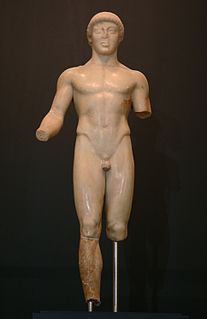
Ephebos (ἔφηβος), also anglicised as ephebe or archaically ephebus, is a Greek term for a male adolescent, or for a social status reserved for that age, in Antiquity.

In Greek mythology, Despoina was the daughter of Demeter and Poseidon and sister of Arion.
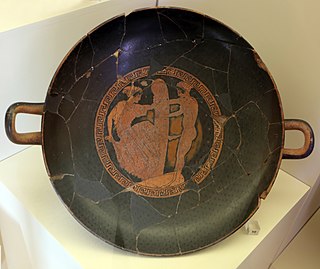
Haloa or Alo (Ἁλῶα) was an Attic festival, celebrated principally at Eleusis, in honour of Demeter, protector of the fruits of the earth, of Dionysus, god of the grape and of wine, and Poseidon, god of the seashore vegetation. In Greek, the word hálōs (ἅλως) from which Haloa derives means “threshing-floor” or “garden.” While the general consensus is that it was a festival related to threshing—the process of loosening the edible part of cereal grain after harvest—some scholars disagree and argue that it was instead a gardening festival. Haloa focuses mainly on the “first fruits” of the harvest, partly as a grateful acknowledgement for the benefits the husbandmen received, partly as prayer that the next harvest would be plentiful. The festival was also called Thalysia or Syncomesteria.

The Archeological Museum of Eleusis is a museum in Eleusis, Attica, Greece. The museum is located inside the archaeological site of Eleusis. Built in 1890, by the plans of the German architect Kaverau, to keep the findings of the excavations, and after two years (1892) was extended under the plans of the Greek architect J. Mousis.

The Ninnion Tablet, dated to approximately 370 BC, is a red clay tablet depicting the ancient Greek Eleusinian Mysteries. It was rediscovered in Eleusis, Attica in 1895, and is kept in the National Archaeological Museum of Athens.

The Sacred Way, in ancient Greece, was the road from Athens to Eleusis. It was so called because it was the route taken by a procession celebrating the Eleusinian Mysteries. The procession to Eleusis began at the Sacred Gate in the Kerameikos on the 19th Boedromion.
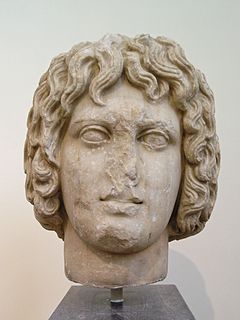
In ancient Greek religion and myth, Eubuleus is a god known primarily from devotional inscriptions for mystery religions. The name appears several times in the corpus of the so-called Orphic gold tablets spelled variously, with forms including Euboulos, Eubouleos and Eubolos. It may be an epithet of the central Orphic god, Dionysus or Zagreus, or of Zeus in an unusual association with the Eleusinian Mysteries. Scholars of the late 20th and early 21st centuries have begun to consider Eubuleus independently as "a major god" of the mysteries, based on his prominence in the inscriptional evidence. His depiction in art as a torchbearer suggests that his role was to lead the way back from the Underworld.
In Greek mythology, Eleusis or Eleusinus, was the eponymous hero of the town of Eleusis.

The mysteries of Isis were religious initiation rites performed in the cult of the Egyptian goddess Isis in the Greco-Roman world. They were modeled on other mystery rites, particularly the Eleusinian mysteries in honor of the Greek goddesses Demeter and Persephone, and originated sometime between the third century BCE and the second century CE. Despite their mainly Hellenistic origins, the mysteries alluded to beliefs from ancient Egyptian religion, in which the worship of Isis arose, and may have incorporated aspects of Egyptian ritual. Although Isis was worshipped across the Greco-Roman world, the mystery rites are only known to have been practiced in a few regions. In areas where they were practiced, they served to strengthen devotees' commitment to the Isis cult, although they were not required to worship her exclusively, and devotees may have risen in the cult's hierarchy by undergoing initiation. The rites may also have been thought to guarantee that the initiate's soul, with the goddess's help, would continue after death into a blissful afterlife.

The Lovatelli urn is a 1st century BCE marble funerary urn from the early Roman imperial period. It is thought to depict Persephone, Demeter and Triptolemus, the triad of the Eleusinian mysteries, however, there are several different competing interpretations about the figures and their meaning in the literature.
References
- ↑ Walter Burkert, Homo necans: interpretationen altgriechischer Opferriten und Mythen (Berolini: DeGruyter, 1972), pp. 306–307.
- ↑ Graf, Fritz; Johnston, Sarah Iles (2013). Ritual Texts for the Afterlife: Orpheus and the Bacchic Gold Tablets. Oxon: Routledge. p. 121. ISBN 9780415508025.
- ↑ III, Radcliffe G. Edmonds (2004). Myths of the Underworld Journey: Plato, Aristophanes, and the 'Orphic' Gold Tablets. Cambridge: Cambridge University Press. p. 105. ISBN 0521834341.
- ↑ Blavatsky, Helena; Pococke, Edward; Taylor, Thomas; Wilder, Alexander (2018). The holy rites of Eleusis were Archaic Wisdom-Religion dressed in Greek garb. Philaletheians UK. p. 49.